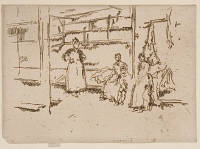Etchings Institutions search term: wunderlich
After the Sale, Clothes Exchange, Houndsditch | ||
| Number: | 357 | |
| Date: | 1887 | |
| Medium: | etching | |
| Size: | 127 x 177 mm | |
| Signed: | butterfly at left | |
| Inscribed: | no | |
| Set/Publication: | no | |
| No. of States: | 1 | |
| Known impressions: | 5 | |
| Catalogues: | K.294; M.289 | |
| Impressions taken from this plate (5) | ||
KEYWORD
TITLE
'After Sale Exchange ' (1887/1888, Whistler). 2
'After Sale (Houndsditch[)]' (1888, Whistler). 3
'After the Sale, Houndsditch' (1902, Edward Guthrie Kennedy (1849-1932)). 4
'After the Sale, Hounsditch' (1910, Edward Guthrie Kennedy (1849-1932)). 5
'After the Sale, Clothes Exchange, Houndsditch' (2012, Whistler Etchings Project).
Since Whistler's original title is not self-explanatory, a fuller title, 'After the Sale, Clothes Exchange, Houndsditch', has been preferred. The spelling Houndsditch is usual although Hounsditch is also acceptable. 6
2: List, [August 1887/1888], GUW #13233.
3: Whistler to Wunderlich's, 29 June 1888, GUW #13052.
4: Kennedy 1902 (cat. no. 282).
5: Kennedy 1910 (cat. no. 294).
6: Thomas Miller, Picturesque Sketches of London, London, 1852; James Greenwood, Journeys; or Byways of the Modern Babylon, London, 1867.
DESCRIPTION
SITE
7: H. Mayhew and John Binny, The Criminal Prisons of London and Scenes of London Life, London, 1862, pp. 39-40.
DISCUSSION
